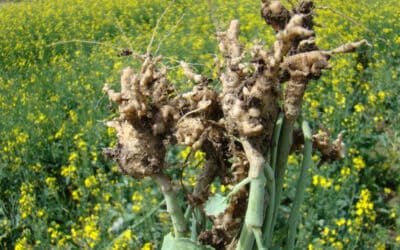The decision-making process on whether to spray for sclerotinia stem rot in canola begins with a moisture assessment about three weeks before flowering. The situation leading up to that point is almost irrelevant, given the canola plant’s ability to crank up yield potential in response to improved growing conditions. Sclerotinia stem rot can go from no risk to high risk with a timely period of regular rains and humidity.
Moisture before flowering will result in the emergence of spore-producing apothecia. Under ideal warm and moist conditions, it takes around three weeks for sclerotia to germinate and release ascospores. Moisture during flowering will enable ascospores to infect canola petals and grow into leaf and stem tissues when the infected petals fall into the crop canopy. Moisture during and immediately after flowering will promote infection that can lead to an economic loss of yield. It is too late to spray after flowering or after symptoms have appeared on the plant, so the decision has to be based on the situation before and during the spray window — which is 20-50% flower — and the forecast of weather and yield to come.
Risk of economic levels of sclerotinia stem rot INCREASES with:
- A history of significant levels of sclerotinia in the specific field or in adjacent fields. Host crops include canola, soybeans, sunflowers, potatoes and pulses.
- The soil surface underneath the canola canopy remains wet for most or all of the day. This promotes germination of sclerotia and production of apothecia, the tiny mushrooms that release sclerotinia spores.
- The presence of apothecia, which are a sign that spores will be present. However apothecia are not always easy to find or distinguish from other mushroom-like fungal bodies that may be present. Other options for spore detection are petal tests and new tools, like the Spornado (20/20 Seed Labs) or DNA-based petal testing kits (Quantum Genetix and Discovery Seed Labs).
- Higher yield situations. This increases the chance that disease pressure will be high, which increases the return on investment for a fungicide spray. Yields are difficult to predict, so a better indicator may be a canopy dense enough to create the humid microclimate that favours disease. If you walk through the canopy in early afternoon and your pants get wet, the field has favourable conditions for infection. (We call this the “wet pants test”.)
- Moderate average temperatures of 15-25°C and moderate rainfall that favour host infection while extending the bloom period and reducing sloughing off of leaves, thus maintaining potential infection sites.
- Extensive sticking/clumping of petals in the crop canopy especially in the leaf axils and bases.
Risk of economic levels of sclerotinia stem rot DECREASES with:
- Dry conditions through the flowering period. If the environment and the canopy is dry during this period, then ascopore release is reduced, ascospores infecting petals is reduced, infection moving into leaves and stems is reduced, and yield loss to this disease is reduced.
- A poor canola canopy that allows for a lot of air flow. When doing the wet pants test, if the canopy and your pants and boots are dry at 8-10 a.m., then the field has less favourable conditions for the disease.
- Well below- or above-average temperatures (<10°C or >25-30°C) and limited rainfall.
- A large rainfall event over 1-2 days that is followed by several days or 1-2 weeks of dry, warm conditions.
- Continuous rain events that may lead to washing off of petals from plants and remove spores from the air, while trapping spores in water droplets that form on the tops of the apothecia. Note however that rain events that actually reduce sclerotinia stem rot risk would be unusual.
Management approaches if the potential for disease is uncertain:
- Apply the lowest rate of fungicide. Use programs or lowest-cost products to keep costs as low as possible. See results from a U.K. fungicide efficacy study.
- Always use highest label water rates to get the most coverage and best efficacy.
- If perked-up fields are to rebound and achieve target yields, they will likely have to branch out and flower for longer. In this situation, ‘full flower’ (50% flower) could last a week or more. This can be an effective time to spray, especially in a situation where moisture changed dramatically for the good and the crop canopy is slowly filling in. The point is that farmers in this situation can afford to wait a little longer to assess crop recovery before making the spray decision.
- Early infections cause more yield loss than later infections, and the economic benefit of a fungicide application is generally higher with early applications. AAFC sclerotinia researcher Kelly Turkington says studies by Morrall et al. (1985, 1989) and Rude (1989) have demonstrated that effective control is possible when disease-favourable environmental conditions do not occur until full bloom. If conditions are favourable throughout the risk period, Rude found that yield losses were significantly higher when canola plants were infected at early bloom than at late bloom. Thus, yield increases achieved by fungicide application at late bloom may not be high enough to provide economic control.
- Consider an ‘on-off’ or zone-spraying approach to fungicide application, basing it on previous yield maps or current NDVI maps. Fungicide application could be turned ‘on’ for areas with high yield potential and ‘off’ for typically low yielding areas.
- If you need to spray so you can sleep at night, then spray. But leave a few test strips to compare disease amounts and yield. This can help with future decisions.
Conditions where a grower may want to spray more than once:
- Variable crop staging that extends the flowering period.
- Thin stands with late branches that extend the flowering period.
- Continued rain throughout flowering may warrant a second application to minimize late season infection. Given the environmental conditions, late season infections don’t typically contribute to yield loss but an application will help reduce inoculum going back to the field.
- Regrowth after a hail.
- Before any second spray (or first spray for that matter) assess yield potential to consider return on investment.
*This article was inspired by a paper called “Managing sclerotinia in oilseed and pulse crops,” printed in Soils and Crops Journal in 2011.
Source: Canola Watch





